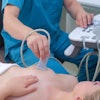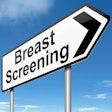
Sunday, November 26 | 11:15 a.m.-11:25 a.m. | SSA02-04 | Room N227B
Contrast-enhanced digital mammography performs comparably to digital mammography and may be a useful screening alternative for women with an intermediate risk of breast cancer, according to this study being presented at RSNA 2017 on Sunday morning.A team led by Dr. Janice Sung of Memorial Sloan Kettering Cancer Center evaluated the performance of contrast-enhanced digital mammography (CEDM) versus digital mammography alone. The researchers included 1,197 screening CEDM exams acquired between December 2012 and April 2016, tracking measures such as the number of biopsies recommended and cancers detected.
Of the total number of screening contrast-enhanced mammograms, 27% were in women with a family history of breast cancer in a first-degree relative, 39% were in women with a personal history of breast cancer, 9% were in women with a known BRCA mutation, and 31% were in women with a history of a high-risk lesion. CEDM found 22 cancers (12 invasive ductal cancers, two invasive lobular cancers, one invasive mammary cancer, and seven cases of ductal carcinoma in situ, or DCIS); its BI-RADS 3 rate was 2%, its positive biopsy (PPV3) rate was 31%, and its cancer detection rate was 18 per 1,000 exams.
CEDM's performance suggests that it could be an effective additional tool in the screening arsenal, Sung and colleagues concluded.
"CEDM is a promising technology that may be used for breast cancer screening of intermediate-risk women," the group wrote. "The BI-RADS 3 rate, PPV3, and relative proportion of DCIS to invasive cancers are comparable to screening mammography."
This paper received a Roadie 2017 award for the most popular abstract by page views in this Road to RSNA section.




















